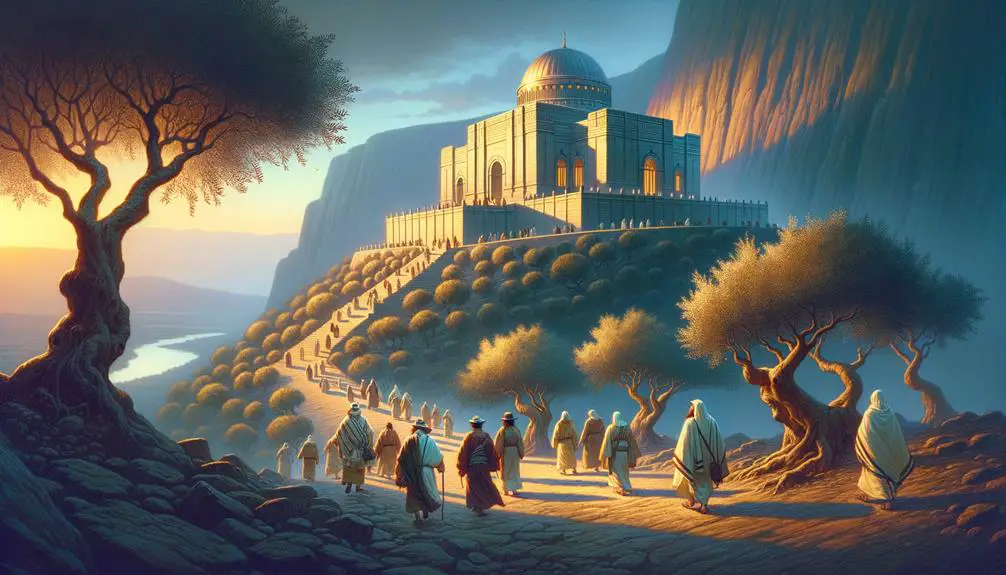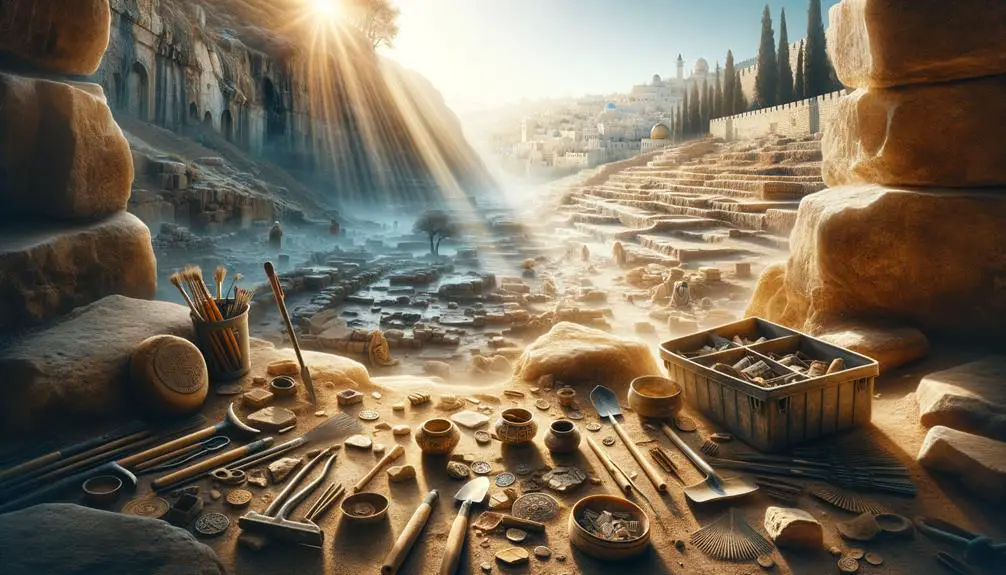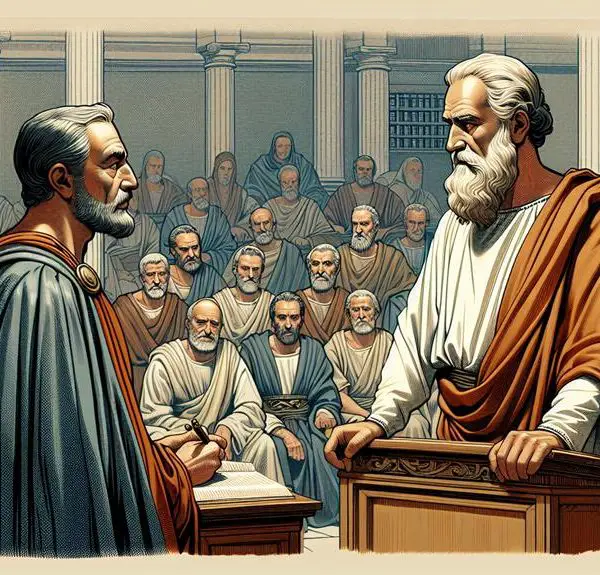Where does Mt. Moriah lie in biblical lore, unveiling secrets that bridge the ancient past with enduring faith?

Where Is Mt. Moriah in the Bible
Mysteries mount and minds meet when you ponder the precise placement of Mt. Moriah in the Bible. This legendary location, pivotal in both the Genesis account and significant in Jewish tradition, has sparked debates among scholars for centuries.
You'll find it fascinating how this single site serves as a crossroads for historical, geographical, and theological discourse. But where exactly is it pinpointed in ancient texts, and what secrets does its soil hold?
Stay with us, and you'll uncover layers of lore that link past to present, inviting a deeper understanding of its enduring essence.
Key Takeaways
- Mt. Moriah is the site of Abraham's test of faith in Genesis, symbolizing submission to divine authority.
- It evolved into Jerusalem's religious nucleus, important in Jewish tradition and Temple Mount worship.
- Archaeological finds at Mt. Moriah offer tangible insights into biblical narratives and ancient worship practices.
- The site embodies themes of faith, obedience, and the divine covenant, pivotal in both Jewish and Christian traditions.
The Genesis Account

Exploring the Genesis account reveals Mt. Moriah as a pivotal location, where Abraham's faith was profoundly tested through God's command to sacrifice his son, Isaac. This event isn't just a narrative but a complex interplay of faith, obedience, and moral questioning that has intrigued scholars and believers alike for centuries. Abraham's obedience to God's command, despite the immense personal cost, highlights a moment of unparalleled faith and trust in divine will.
The sacrifice dilemma faced by Abraham on Mt. Moriah is central to understanding the depth of his commitment to God. It presents a paradox that challenges conventional morality; the command to sacrifice his son stands in stark contrast to the promise God made to Abraham, that his descendants would become a great nation. This tension between divine command and moral expectation forces a reevaluation of what it means to be obedient and faithful.
Analyzing this account, one realizes that Abraham's journey to Mt. Moriah is symbolic of ultimate submission to divine authority. His willingness to sacrifice Isaac, even in the face of such a profound personal and ethical dilemma, is a testament to his unwavering faith. This narrative doesn't merely recount a historical event but delves deep into the themes of faith, obedience, and the human condition when confronted with divine directives.
Thus, the Genesis account of Mt. Moriah serves as a foundational text, offering insights into the complexities of faith and the nuances of human-divine interaction. Abraham's obedience and the sacrifice dilemma underscore the profound and often perplexing nature of absolute faith.
Historical and Geographical Context
To fully appreciate the significance of Mt. Moriah in biblical narratives, it's essential to delve into its historical and geographical context. The Moriah etymology remains a topic of scholarly debate, yet it's often associated with notions of 'chosen by Yahweh' or 'seen by Yahweh,' which underscores its revered status in ancient texts. Understanding the etymology provides a foundation for grasping the profound spiritual implications attributed to this location throughout history.
Historically, Mt. Moriah is closely linked to pivotal biblical events, most notably the near-sacrifice of Isaac by Abraham, a foundational story in Judeo-Christian tradition. This act of faith and obedience is said to have taken place on this very mountain, highlighting its significance as a site of divine-human interaction.
Geographically, identifying the modern location of Mt. Moriah brings us to the heart of Jerusalem, where the Temple Mount stands today. This site has undergone extensive transformations over millennia, evolving from a remote hilltop to the nucleus of religious reverence. The Temple Mount, recognized as Mt. Moriah's present-day embodiment, has served as a focal point for worship and pilgrimage, reflecting its enduring importance across generations.
The transition from a historical mount in ancient narratives to its modern embodiment in Jerusalem underlines the continuous reverence and spiritual significance attributed to this site. By examining the Moriah etymology and its modern location, you gain insight into the deep layers of religious, historical, and geographical significance that have shaped human understanding of this sacred space through ages.
Significance in Jewish Tradition

In Jewish tradition, Mt. Moriah holds paramount significance as the site where Abraham's faith was tested by God's command to sacrifice his son Isaac. This event, known as the Akedah, anchors the mountain's sacred status, profoundly influencing subsequent religious narratives and practices. It's not merely a historical or mythological site; it represents a cornerstone of faith, obedience, and divine intervention in Jewish lore.
Central to Mt. Moriah's significance is its identification with the Temple Mount in Jerusalem, a locus of Jewish worship and sacrificial practices. The First and Second Temples, pivotal in Jewish religious life, stood there, serving as the heart of Jewish worship and community. The temples weren't only architectural marvels but also the epicenter of Jewish sacrificial practices, integral to maintaining the covenant with God. The destruction of these temples marked catastrophic events in Jewish history, yet the reverence for the site persists, embodying the eternal bond between the Jewish people and their divine covenant.
The enduring sanctity of Mt. Moriah in Jewish tradition underscores its role not just as a historical site but as a living symbol of faith, resilience, and continuity. Its association with the Temple Mount and sacrificial practices enriches the Jewish historical narrative, providing layers of religious and cultural significance that resonate throughout centuries. The story of Abraham and Isaac, together with the legacy of the temples, illustrates the profound bond between the Jewish people, their land, and their God—a relationship that continues to shape the Jewish identity and spiritual life.
Christian Interpretations
While Jewish tradition venerates Mt. Moriah for its profound biblical connections, Christians also imbue the site with significant theological interpretations, viewing it through the lens of typology and prophecy fulfillment. For Christians, Mt. Moriah isn't just a historical or geographical landmark; it's a prefiguration of Christ's sacrifice, deeply embedded with sacrificial symbolism and narratives of divine tests.
Here, let's explore four key aspects that highlight the Christian perspective on Mt. Moriah:
- Typology of Sacrifice: Christians see Abraham's willingness to sacrifice Isaac on Mt. Moriah as a foreshadowing of God's willingness to sacrifice His own Son, Jesus Christ. This parallel draws a profound connection between the two events, emphasizing the theme of ultimate sacrifice for the greater good.
- Fulfillment of Prophecy: The location of Mt. Moriah, later becoming the site of the Jewish temple, is interpreted by Christians as the fulfillment of Old Testament prophecies. They view it as a symbolic precursor to the coming of Christ, who's seen as the true temple and final sacrificial lamb.
- Divine Tests: The story of Abraham and Isaac is often cited as an example of faith and obedience to God's will. Christians interpret this as a lesson on the importance of trust in divine plans, even when they seem incomprehensible.
- Sacrificial Symbolism: The act of sacrifice on Mt. Moriah resonates with Christian teachings on redemption, salvation, and the necessity of sacrifice for atonement. This symbolism enriches Christian liturgy and theology, making Mt. Moriah a key element in understanding the nature of Jesus' mission.
In this analytical view, Christians discern in Mt. Moriah a rich tapestry of sacrificial symbolism and divine tests, offering deep insights into their faith's core tenets.
Archaeological Insights

Archaeological explorations at Mt. Moriah offer tangible insights into the biblical narratives, grounding them in historical reality. You'll find that the layers of history buried beneath this sacred site tell a story not just of religious significance but of human endeavor, resilience, and the quest for understanding our past. The challenges faced during excavation, including the delicate nature of artifact preservation, are testament to the dedication of archaeologists in uncovering the truths held within the earth.
The task of digging into this revered ground comes with its own set of challenges, primarily due to the site's religious significance and the technical difficulties of ensuring that the artifacts unearthed are preserved and studied with the utmost care. The table below showcases the major finds, excavation challenges, and the methods used in artifact preservation at Mt. Moriah:
Major Finds |
Excavation Challenges |
Artifact Preservation Methods |
|---|---|---|
Ancient pottery |
Sensitive religious site |
Controlled environment storage |
Inscriptions |
Hard rock layers |
Digital 3D mapping |
Religious artifacts |
Political tensions |
Chemical stabilization |
Architectural remnants |
Environmental conditions |
In situ preservation |
Coins dating back millennia |
Limited access |
Micro-environmental controls |
This table conveys not just the variety of discoveries made but also highlights the multifaceted approach required to tackle the hurdles presented by such a complex site. The archaeological insights gained from Mt. Moriah extend beyond mere academic interest, offering a bridge between the past and the present, and enabling a deeper understanding of the historical context of the Bible. Through meticulous excavation and artifact preservation, scholars continue to unravel the mysteries of this ancient and holy place, bringing to light the stories that have shaped our collective heritage.
Frequently Asked Questions
How Has the Interpretation of Mt. Moriah's Location Evolved in Modern Religious Scholarship Outside the Traditional Abrahamic Faiths?
In recent scholarship, the location of Mt. Moriah's significance has expanded through cultural syncretism and philosophical interpretations. Scholars outside traditional Abrahamic faiths delve into its metaphorical aspects, analyzing how its symbolism merges with broader spiritual narratives.
This evolution reflects a scholarly shift towards appreciating the intersection of historical faith traditions and broader philosophical inquiries, offering a richer, more nuanced understanding of its place in religious and cultural discourse.
Are There Any Environmental or Ecological Studies Conducted on or Around Mt. Moriah That Reveal How the Landscape Has Changed Over Millennia?
Yes, environmental and ecological studies on Mt. Moriah have unveiled the landscape's resilience over millennia. Coincidentally, these insights deepen your understanding of the area's historical and cultural significance.
Biodiversity studies, in particular, shed light on how flora and fauna have adapted, offering a unique lens through which to view ancient narratives. This analytical approach not only enriches historical interpretations but also emphasizes the interconnectedness of nature and human history.
How Do Contemporary Local Communities Living Near the Traditional Locations Identified as Mt. Moriah Relate to or Interact With This Biblical Site Today?
You'll find that contemporary local communities near Mt. Moriah actively engage with the site through local festivals and initiatives aimed at community development. These interactions not only honor their historical and spiritual connections but also demonstrate a dynamic relationship with the landscape.
Such engagements contribute to a deeper understanding of the area's significance, fostering a sense of unity and purpose among inhabitants, while also promoting cultural and ecological awareness.
What Role Does Mt. Moriah Play in Artistic and Literary Works That Are Not Directly Religious or Historical Texts?
You'll find that Mt. Moriah's significance transcends its biblical roots, serving as a beacon of artistic inspiration. Its symbolism, rich in layered meanings, offers a fertile ground for creators.
In non-religious and non-historical texts, it acts as a metaphor for faith, sacrifice, and the human condition, inviting a deeper exploration of universal themes.
Moriah's enigmatic presence in art and literature prompts an analytical dive into its multifaceted influence beyond conventional narratives.
How Have Geopolitical Conflicts in the Region Affected Archaeological Endeavors and the Preservation of Sites Associated With Mt. Moriah?
Geopolitical conflicts have significantly hindered archaeological excavations and the preservation of sites around Mt. Moriah. You're facing excavation challenges due to restricted access and potential damage from ongoing tensions.
Preservation technologies are crucial here but often can't be fully implemented. These conflicts obstruct not only the physical preservation but also the scholarly understanding of the area's historical and cultural significance, making your efforts to study and protect these sites increasingly complex.
Conclusion
In conclusion, Mt. Moriah stands as a historic and spiritual lighthouse, illuminating paths in Jewish and Christian traditions. Its roots, deeply embedded in the Genesis narrative, extend through layers of history and belief, offering a rich tapestry for scholarly exploration.
Archaeological insights continue to peel back the layers, revealing the complexity of its significance. As a crossroads of faith, history, and scholarship, Mt. Moriah remains a pivotal point of convergence, inviting ongoing analysis and interpretation.



Sign up